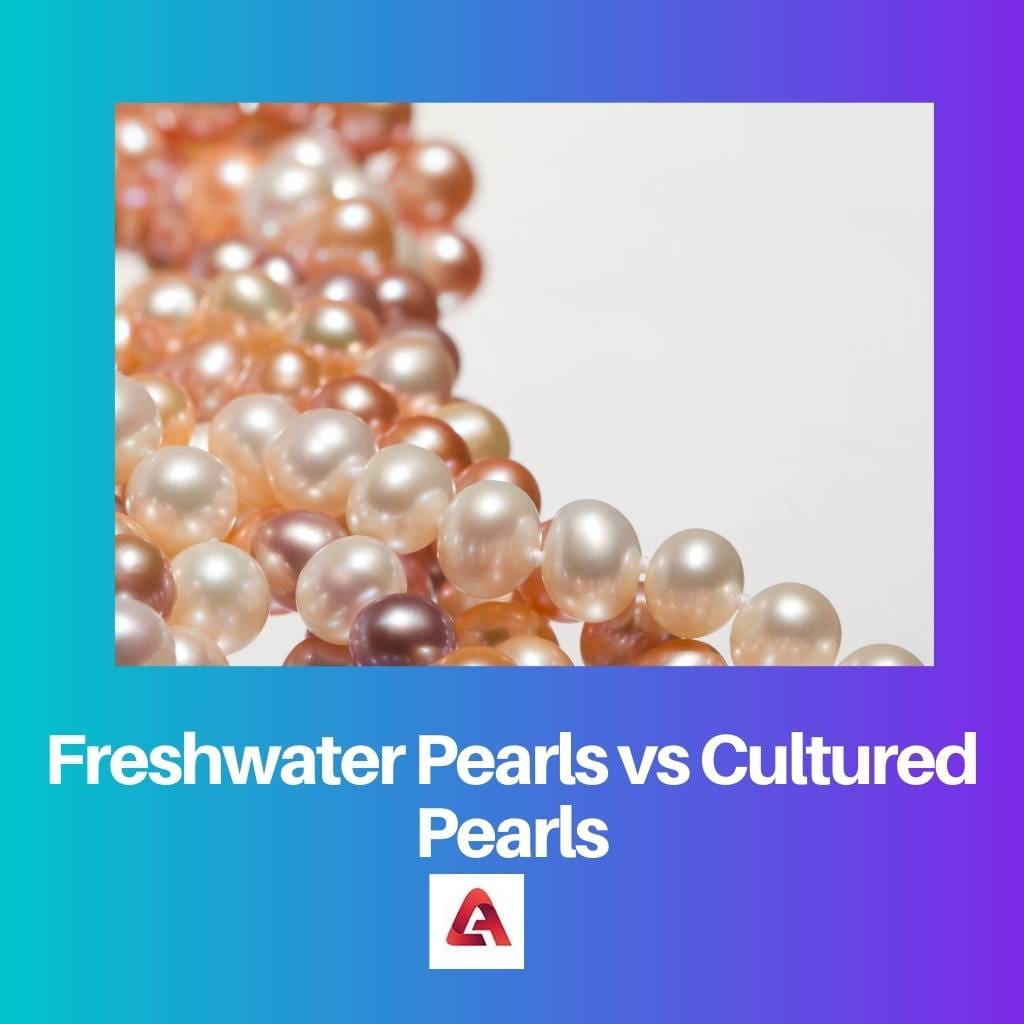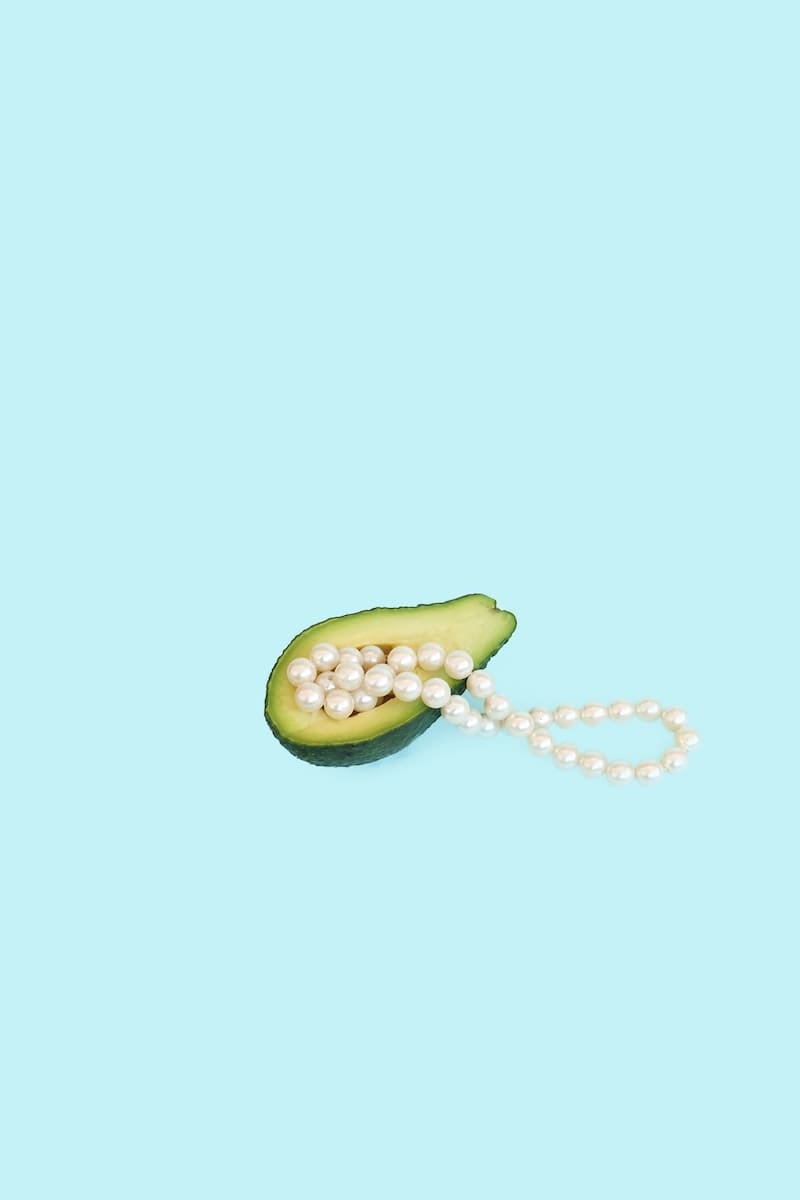Various types of pearls can be found if searched properly – Saltwater pearls, Natural pearls, South Sea pearls, Cultured pearls, Tahitian pearls, Blue pearls, Freshwater pearls, Mabe pearls, Keshi pearls, and Imitation pearls.
Among them, the most common types include Freshwater pearls and Cultured pearls.
Key Takeaways
- Freshwater pearls are formed naturally in freshwater mollusks, while cultured pearls are formed through humans’ deliberate insertion of an irritant into a mollusk.
- Freshwater pearls are smaller and less expensive than cultured pearls, which are larger and round.
- Cultured pearls can come in more colors and shapes than freshwater pearls.
Freshwater Pearls vs Cultured Pearls
The difference between freshwater pearls and cultured pearls is that a freshwater pearl is synthesized organically, while a cultured pearl is synthesized artificially. Saltwater pearls do not come under this category, though they are produced naturally. At times, cultured pearls are sold out as freshwater pearls at hefty prices to fool customers who cannot distinguish between the two discrete types of pearls based on quality.

All freshwater pearls require a long duration for formation. Many of the oceanic currents and other atmospheric parameters fuel the formation of such pearls.
They are solely based on the chance of a particular particle entering the mollusk on its own. Not all freshwater pearls are relevant, as many of them get spoilt due to excess pressure or are damaged during forceful extraction.
It is essential to maintain them after extraction for better longevity.
All cultured pearls require a particular artificial environment so that they can transform quickly. After the insertion of an artificial irritant or particle into the mollusk, the whole setup is monitored till the time a pearl is seen.
Many complex machines are involved in the process. Unlike freshwater pearls, these are produced in abundance, and there is no need to search for them in the wild.
All cultured pearls are equally sturdy and attractive.
Comparison Table
| Parameters of Comparison | Freshwater Pearls | Cultured Pearls |
|---|---|---|
| Definition | Naturally-occurring pearls, without any human intervention | Artificially synthesized pearls produced by humans |
| Methodology of Formation | Particles enter mollusks on their own | Particles are forcefully inserted into mollusks |
| Price | Too expensive due to high demand | Moderately priced due to ample availability |
| Place of Origin | Found in the wild and hard-to-reach areas | Can be easily bought from the market |
| Probability of Occurrence | Rarely found due to widespread population | Commonly available in markets since production is increased based on demand |
What are Freshwater Pearls?
Freshwater pearls are also known as natural pearls (among other exclusive and rare varieties). They are highly significant due to their organic value and are considered to be precious gems.
It is believed that the natural synthesis of pearls makes them harder, and the natural white shine is enough to impress the viewer. Cleaning these pearls is a gruesome process as a lot of filth and residue gets attached during the formation period.
It is quite easy to spot a freshwater pearl from a group of mixed pearls since they have an eye-catching glistening appearance. Some wild pearls are treated as rarities due to their scarce occurrence.
The harvesting of freshwater pearls is also an important step. In some cases, the collectors keep the pearls in a safe environment as soon as the quality is identified.
The significance of freshwater pearls lies in the fact that they undergo various atmospheric pressures to take such a shape and shine. In this way, freshwater pearls and other naturally occurring pearls can also be considered to be the gifts of nature.
The best way to preserve freshwater pearls is to save them from chemical contamination. The age of a freshwater pearl cannot be determined without understanding the full process of formation.

What are Cultured Pearls?
Cultured pearls are also known as artificial pearls. The various applications of cultured pearls include the creation of artificial jewelry and the enhancement of several decorative pieces.
There are specific laboratories for synthesizing these pearls as the low price leads to huge demand. Cultured pearls are further divided into two types – actual pearls and duplicate pearls.
The latter category includes pearls made of plastic as well. On the other hand, actual pearls go through the same formation as natural pearls.
They can be distinguished based on their hardness and appearance. The quality of cultured pearls can easily be enhanced or downgraded.
It is determined by the type of mollusk chosen and the irritant inserted inside it. In most cases, the time of synthesis is more or less the same.
There is an advantage related to the creation of cultured pearls as well – they do not need any initial cleaning since they are produced in controlled conditions inside a laboratory.
Due to the large-scale production of cultured pearls, the use of pearls in jewelry formation is no more limited to affluent designers. Such pieces can be polished diligently to match the crystallized look.

Main Differences Between Freshwater And Cultured Pearls
- A freshwater pearl is a pearl that forms naturally, while a cultured pearl is artificially synthesized.
- The formation of a freshwater pearl does not include human intervention, unlike cultured pearls.
- The price of a freshwater pearl is comparatively higher than that of a cultured pearl.
- Freshwater pearls occur in the wild, but cultured pearls can be purchased from markets.
- It is quite rare to spot a freshwater pearl, but cultured pearls are widely available.

- https://www.sciencedirect.com/science/article/pii/S0928493105003590
- https://www.researchgate.net/profile/Kenneth-Scarratt/publication/263699057_The_Current_Status_of_Chinese_Freshwater_Cultured_Pearls/links/0f31753bb818423708000000/The-Current-Status-of-Chinese-Freshwater-Cultured-Pearls.pdf

The section on cultured pearls sheds light on their different applications and the process of synthesis. It’s fascinating to know about the various types of cultured pearls and how they are distinguished based on quality.
This is a very informative article on the different types of pearls and how they are formed. It’s interesting to know the differences between freshwater pearls and cultured pearls, especially in terms of their formation.
I agree, freshwater pearls and cultured pearls have unique qualities that make them valuable in their own way. The comparison table provides a clear outline of the differences.
The detailed explanation of freshwater pearls and cultured pearls is quite intriguing. It’s fascinating to learn about the natural formation of freshwater pearls and the artificial synthesis of cultured pearls.
The information about freshwater pearls and cultured pearls is well-explained. Understanding the differences in their definition, place of origin, and methodology of formation is crucial for distinguishing between the two types of pearls.
Absolutely, the significant differences between freshwater pearls and cultured pearls are highlighted clearly. It’s important to recognize the organic nature of freshwater pearls and the artificial synthesis of cultured pearls.
The information about freshwater pearls and cultured pearls is highly educational. The section on the significance of freshwater pearls and the environmental factors that influence their formation is particularly interesting.
I agree, the environmental factors that impact the formation of freshwater pearls provide valuable insights into their natural occurrence.
The detailed explanation of cultured pearls and their applications is quite enlightening. The categorization of actual pearls and duplicate pearls is an interesting aspect to consider.
The comparison table provides a comprehensive overview of the differences between freshwater pearls and cultured pearls. It’s helpful to understand the distinct characteristics of each type of pearl.
The article effectively highlights the significance of freshwater pearls and the meticulous process of their formation. The synthetic nature of cultured pearls and their distinct categories of actual pearls and duplicate pearls are intriguing.
The detailed comparison between freshwater pearls and cultured pearls in the context of their rarity and availability is thought-provoking. It provides a thorough understanding of the unique characteristics of both types of pearls.
Absolutely, the rarity and availability of freshwater pearls and cultured pearls are crucial factors to consider when evaluating their value.
The comparison between freshwater pearls and cultured pearls in terms of their marine origin and formation is insightful. It’s intriguing to learn about the atmospheric pressures that freshwater pearls undergo for their formation.
Absolutely, the intricate details about the formation and preservation of freshwater pearls provide a thorough understanding of their natural occurrence.
The article effectively describes the significance of freshwater pearls and how they are considered to be precious gems. The detailed explanation of the harvesting and preservation of freshwater pearls provides valuable knowledge.
The section on the probabilities of occurrence between freshwater pearls and cultured pearls provides valuable insights. It’s interesting to know that freshwater pearls are rarely found due to widespread population, whereas cultured pearls are commonly available since production is increased based on demand.